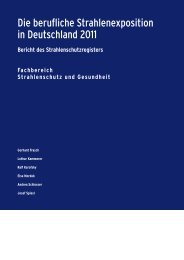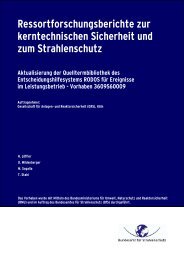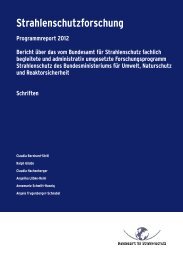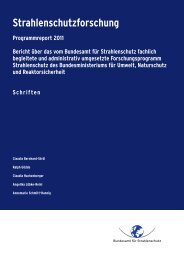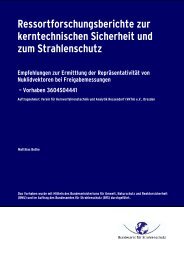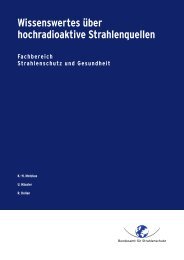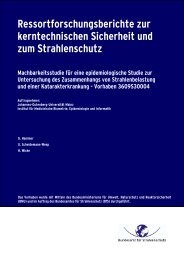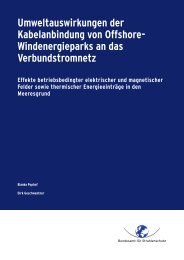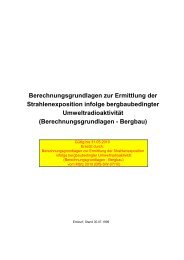Ressortforschungsberichte zur kerntechnischen Sicherheit und zum ...
Ressortforschungsberichte zur kerntechnischen Sicherheit und zum ...
Ressortforschungsberichte zur kerntechnischen Sicherheit und zum ...
Sie wollen auch ein ePaper? Erhöhen Sie die Reichweite Ihrer Titel.
YUMPU macht aus Druck-PDFs automatisch weboptimierte ePaper, die Google liebt.
- Investigation of confo<strong>und</strong>ers for the development of cataracts by relevant questioning.<br />
Minimisation of information bias.<br />
6.2 Results of work package 2<br />
Work package 2 gives an overview of all collectives that can be considered for an epidemi-<br />
ological study on the relationship between exposition with ionizing radiation and the devel-<br />
opment of cataracts in Germany. Radiation exposed occupational and patient groups as well<br />
as population-based cohorts were checked for their suitability for an epidemiological study<br />
according to the quality criteria mentioned in work package 1. Methodological aspects as<br />
well as feasibility aspects were taken into consideration. Several collectives were identified,<br />
which are suitable in principle for an epidemiological study.<br />
Among the occupational collectives, the groups of interventional cardiologists and radiolo-<br />
gists, as well as of flight crews are those with the highest success chance for gaining sub-<br />
stantial results on the dose-dependancy between low dose ionising radiation and cataract<br />
development from an epidemiological study. The two collectives are large and quite ho-<br />
mogenous. They belong to the job groups with the highest exposure. A good dosimetry as<br />
well as a good, prospective cataract diagnosis can be achieved in both cases. In both collec-<br />
tives a high participation rate can be expected among the study subjects of both collectives.<br />
Regarding the occupational group of nuclear power workers, the experience of the authors<br />
from a study on cancer among this population shows that the recruitment of such a cohort in<br />
Germany might be difficult.<br />
Other groups registered in the radiation protection register are heterogeneous and scattered<br />
which would lead to a high logistical complexity. Patient collectives are heterogeneous, and<br />
the number of patients per clinic exposed to radiation in the head or neck is too small to<br />
perform a study. A further large study collective, which could potentially be a basis for a<br />
case-control study, are people with cataract, but occupational or medical radiation expo-<br />
sures in this collective are rare. However, a collective like this is easy to recruit due to their<br />
presence on the spot and is therefore suitable to optimize e.g. the questionnaire and eye<br />
examination. Population-based cohort studies contain few patients exposed to radiation that<br />
goes beyond short diagnostic radiography, and former studies hardly ever included cataract<br />
examination. In the Gutenberg Heart Study performed at the University Medical Center<br />
Mainz a cataract examination is carried out, but the examinations are not done with a<br />
dilated pupil, which would be necessary for the planned study.<br />
– 82 –



